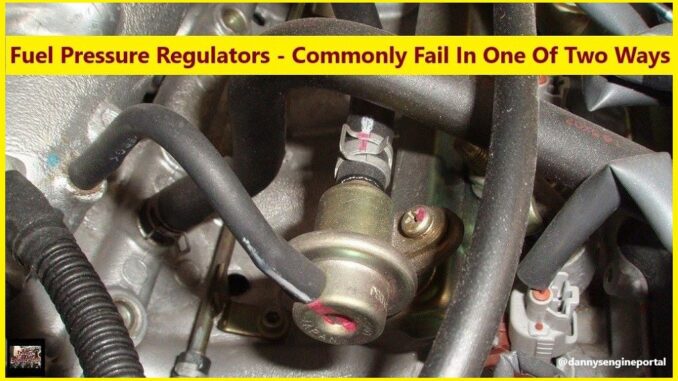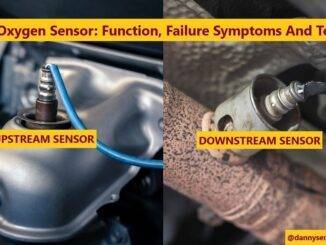
All fuel-injected engines, have fuel pressure regulators to maintain a regulated high-pressure level.
Fuel pressure regulators, must keep the pressure constant, in order for all the components of the system to work properly.
Consequently, if the pressure is out of this range, then the vehicle will not run or will run inefficiently.
So, fuel pressure regulators, keep the fuel pressure, between 25 to 60 pounds, depending on the vehicle.
How Does The Regulator Work
There is a main fuel line, from the fuel tank to the fuel rail. Also, a return fuel line, from the fuel pressure regulator. This return line is located, downstream of all the injectors.
Most fuel pressure regulators, use a diaphragm and spring combination within its housing. And, a vacuum source, on the top side of the diaphragm.
This is to counteract the spring pressure, when high demand dictates, that higher fuel pressure is necessary.
So, a sudden drop in vacuum, will affect fuel pressure. As a result, the fuel injectors will open wide. Because of this, a few moments are needed, by the fuel injectors, to catch up to the pressure created. During these moments, the fuel pressure regulator, temporarily, shuts down the fuel return line. As a result, boosting up the fuel pressure.
The Computer Uses Sensors To Determine:
- Air temperature
- Air density
- Engine load
- Throttle position
- Engine temperature
So, using this information, the computer decides the strategy, that will result in the best performance of the engine.
And, a smoother running engine keeps cooler and helps with overheating.
How Can Fuel Pressure Regulators Fail
Usually, In One Of Two Ways:
- When it fails to hold pressure, it provides too little fuel to the engine, causing a “lean fuel mixture” condition. (low fuel pressure).
- When the fuel pressure regulator gets stuck and builds up more pressure then it should. Then, it will cause the injectors to deliver too much fuel, causing a “rich fuel mixture” condition. (high fuel pressure).
Common Failure Signs Include:
- Spark plugs blackened
- The dipstick smells of fuel
- Fuel drips out of the exhaust pipe
- Engine stalls
- Fuel in the vacuum hose
- Deceleration problems
- Bad fuel mileage
A Failing Regulator May Set Off A (DTC)
Common (DTC) Include:
- P0089: Regulator Performance
- P0090: Regulator Control Circuit / Open
- P008A: System Pressure Too Low
- P0087: Fuel Rail/System Pressure Too Low
- P0088: Fuel Rail / System Pressure – Too High
- P228B: Regulator 2 – Forced Engine Shutdown
- P228C: Regulator 1 Exceeded Control Limits – Pressure Too Low
- P228D: Regulator 1 Exceeded Control Limits – Pressure Too High
- P2293: Regulator 2 Performance
- P2295: Regulator 2 Control Circuit Low
- P2296: Regulator 2 Control Circuit High
Testing For Vacuum And Leaks
The easiest way to test fuel pressure regulators, is with the use of a fuel pressure gauge.
So, this test checks the operation of the fuel pressure regulator. And, makes sure it changes line pressure, in response to changes in engine vacuum. In addition, this is necessary to maintain the correct operating pressure, behind the injectors. Also, to compensate for changes, in engine load.
Testing With A Fuel Pressure Gauge
With the engine running, disconnect the vacuum hose, from the pressure regulator. As a rule, fuel system pressure should increase, 8 to 10 (PSI), with the line disconnected. No change would indicate, a faulty pressure regulator, or a leaky or plugged vacuum line.
Also, when the vacuum hose is disconnected from the regulator, check the inside of the hose for any wetness. Because, that would indicate, fuel is being sucked into the hose. There should be none. The diaphragm inside the regulator is leaking, if there is fuel in the hose.
As a result, this will cause a drop in fuel pressure. And, allow fuel to be sucked, into the intake manifold, upsetting the “air fuel” mixture. So, if the diaphragm is leaking, replace the regulator.
In Summary: Fuel Pressure Regulators
So, always replace your fuel filter, at the recommended manufacturer intervals. Because, a clogged filter will cause fuel pressure to drop, damaging the fuel pump as well. So, it’s more cost effective, to service the fuel filter at regular intervals.
Thank You!




